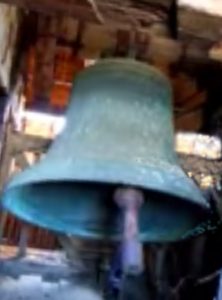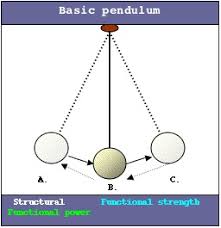No, now it doesn’t get esoteric, although I am asked that again and again, somewhat mockingly, when I bring the pendulum motion into play.
But many movements in tango can be perfectly explained with the pendulum movement. So, let’s take a look at a pendulum.
I’m neither a physicist nor a mathematician, so I’ll keep the description simple.
The pendulum is suspended from one point and, once set in motion, swings from side to side.
At the highest point, the turning point, it pauses for a moment and then swings back again. Each of us has probably seen this before.
At the turning point, the pendulum has its highest potential energy, which, as soon as it swings down, is converted into kinetic energy. Driven by the kinetic energy, the pendulum is carried up on the other side until it reaches the turning point again. The movement of the pendulum is, at least with a large pendulum, very dynamic on the one hand, but also very calm on the other.
How can we make use of the pendulum principle when dancing tango?
One of my most popular pendulum examples in our courses is the “lead” and accompaniment of the lady’s backward ochos.
We swing from left to right and back again.
When we have landed on our right leg, for example, we stand on it for a moment.
By the weight of the free leg hitting the standing leg and the moment of inertia our body automatically is turned counterclockwise, if we are standing straight with a good posture.
This moment corresponds to the turning point of the pendulum, I also call it a moment of silence.
The left leg (at this moment the free leg) is not put down (shifting weight to the left leg), but hangs freely at the hip joint.
If we relax the right leg and the movement continues, the left leg will swing to the left, land on the dance floor and become the standing leg. We straighten up on our axis, the right leg (now the free leg) falls to the left leg (now the standing leg), but is not loaded and can swing back freely.
The weight of the free leg in combination with our intencion ensures that our body moves on.
This pendulum-based movement is both dynamic and calm. Leading ochos becomes easy and practically works by itself.
Two more things are important:
On the one hand, the free leg that falls to the supporting leg is not loaded because otherwise the flow of movement is interrupted.
 You can imagine it like a large church bell swinging back and forth in the church tower. As long as it can swing freely, once it has been set in motion, it will swing without much effort.
You can imagine it like a large church bell swinging back and forth in the church tower. As long as it can swing freely, once it has been set in motion, it will swing without much effort.
But if it touches the floor of the church tower (with very unpleasant consequences for that church tower) and comes to stand there, it would be extremely difficult to pull it up again and make it swing.
On the other hand, the pendulum movement in this case is not linear, but diagonally towards the lady.
The gentleman aims with his free leg at the lady’s free leg.
Swinging back and forth on a line is exhausting for the lady in the long run, because she has to make a 180 ° turn every time and twist herself strongly. It’s also boring and doesn’t get us an inch forward in the line of the dance.
We also find the pendulum principle in other movements in tango. For example at the caminada, walking in tango. Every time we straighten up after a step or several steps in the axis to start the next step, or when changing direction in the Molineta. There will be more about this in another blog post soon.
This article also might be interesting for you.

